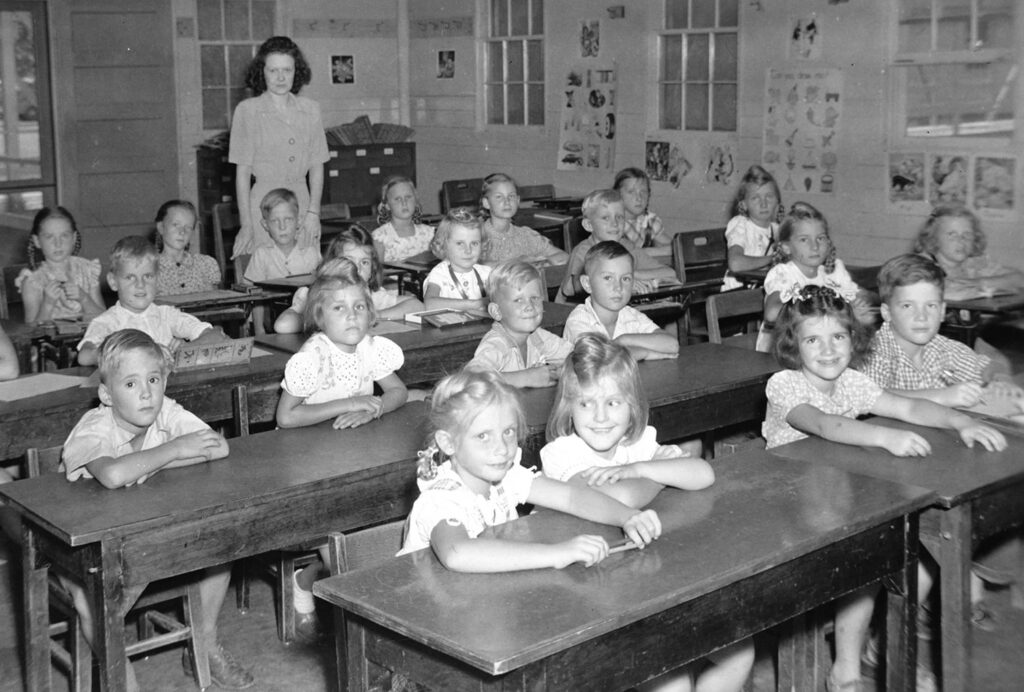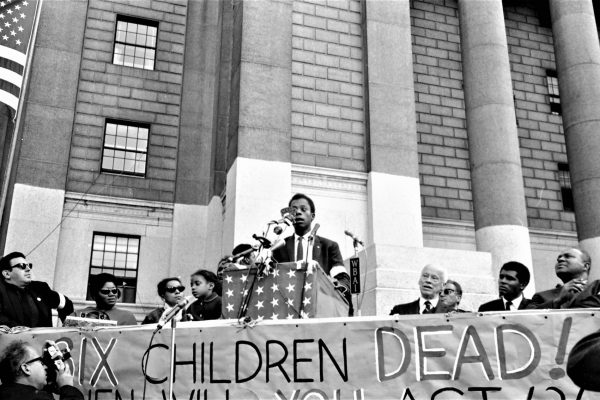In one of the first acts of the Cold War, U.S. War Department officials recruited Nazi scientist Johann Tschinkel, along with 117 other scientists who had designed Hitler’s V-2 missile, to build a weapon under a program called Operation Paperclip. Once in the U.S., Tschinkel recalled that he could “line up excuses” for why he had consented to the Nazi regime and yet “the question remained: I had known about the persecution of Jews, Socialists and other regime adversaries.” He had watched his wife’s uncle being forced to wear the yellow star, and he had not helped him when he was imprisoned in Theresienstadt and then Treblinka, where he died. He had “heard rumors” about other concentration camps in Poland, and he knew people tried to emigrate. He realized he had not worked with any Jews since 1938.
Yet nothing in his past prepared him to resist; everything about his childhood education, both scholastic and social, had prepared him to collude. Born in 1907, Tschinkel believed that opposing Nazism “would have meant the forsaking of my circle of friends and [an] ingrained sense of law and order” he had spent a lifetime developing. “Many of the ethnic and nationalistic ideals with which I had grown up,” ideals he learned through history lessons and youth movements, embraced “the superiority of German culture and the Aryan race.” In his ruminations, Tschinkel identified how the seeds of Nazism were sown long before Hitler, not least through the political and social education of generations of youth.
Germany, of course, was not the only society indoctrinating its youth with ideas about race. Cold War–era campaigns aimed at preserving school segregation were waged in part over an understanding that what children learn about society while in school has lasting effects, both on the kinds of citizens they grow up to be and on the racial and class structures that seem natural to them. Just as Tschinkel saw his own past as preparing him to accept Nazi beliefs, American children were absorbing lessons about their own positions in a highly stratified and unequal society.
These historic struggles over the meaning of childhood and the role of schooling in shaping the social order have taken on new resonance in the past year. The heated demonstrations over critical race theory that have ravaged school board meetings and state legislatures have arisen from a renewed understanding that schools do not simply echo social, political, and cultural power but also create them. The slate of new laws and policies—Texas’s book banning campaign, the censorship of educators who have supported Black Lives Matters, the recent onslaught of “Don’t Say Gay” bills—seeks to ensure the future of political conservatism by shaping the beliefs of future voters.
At the center of the drama lies conservatives’ concern for white children’s happiness and a fear of white guilt. Take, for example, Oklahoma HB 1775, which prohibits schools from teaching anything that might make a student “feel discomfort, guilt, anguish or any form of psychological distress on account of his or her race or sex.” Justifying an identical clause in Texas’s bill, state representative Steve Toth explained, “we don’t need to burden our kids with guilt for racial crimes they had nothing to do with.” From California to Virginia, parents have protested curricula that supposedly tell students “if you’re white, you’re guilty.”
What is at stake is nothing less than the kind of society children will grow up to inhabit, and the social roles those children will occupy. Conservatives seek to assert continued dominance over a school system that was, in meaningful senses, designed for white children’s advancement. Tschinkel’s ruminations might serve as a warning for us now about why they cannot be permitted to succeed.
On a December night in 1946, the first fifteen Paperclip children and their mothers set sail on the USNS Goethals from Bremerhaven, Germany, for Hoboken, New Jersey. It was the first leg in their journey to El Paso, Texas, where they would join their fathers at Fort Bliss to live in former hospital barracks now surrounded by barbed wire. As the families sailed, the children spent an evening singing a selection of German children’s songs for U.S. naval officers. They closed with “The Star-Spangled Banner,” sung in English, a language the children did not know. The performance “was the highlight of the whole voyage,” the ship newsletter recorded, a period of relief in a trip that had been “grey and rough.” Much like the children themselves, the concert offered a respite from a morally complicated affair.
The evening anticipated some of the ways Americans would use the children as a symbol of the allure of Americanization. The scientists, who had relocated six months earlier, had been assured that their wives and children could accompany them from their earliest discussions with U.S. military officials. The Joint Intelligence Objectives Agency (JIOA), the primary organization responsible for recruiting the scientists, knew they would never win them without their families. They also recognized that the children could reshape the scientists’ public image, which in turn might make the public think favorably of Operation Paperclip itself. In seeing that the children promised to “do more to civilize [their] families than most anything else,” as Lois Godfrey, the children’s Army liaison described it, the designers of Operation Paperclip valued the participants that history has most overlooked.
JIOA officials’ confidence flew in the face of the popular sentiment that German children were “the most rabid Nazis,” shaped by the only political system they had ever known. Though only 6 of the 144 Paperclip children were, in reality, old enough to have been Hitler Youth, it was a subtlety many Americans could well have overlooked. Alicia Swann, principal of Crockett Elementary School, which would accept the greatest number of Paperclip children, had recently raised funds to purchase a large stained-glass window to commemorate the school’s war dead. Principal since 1923, just three years after the school was founded, Swann probably knew everyone it memorialized. Yet, within months she testified that “in spirit and in thinking [the children] are American, for they have a happiness here they have never known before.”
Former Paperclip children have echoed this quick acceptance by teachers and other students. Henry Tschinkel, Johann’s eldest child, remembers: “We had expected and we had been warned that there might be a lot of resentment. A year after World War II, the enemy was there in their school. So we were taught to keep a low profile.” But there was little apparent resentment. Bernd Seiler, seven years old when he arrived, recalls: “Now here come all these foreigners, and not only are they foreigners but they were the enemy. . . . And yet . . . at no time can I recall any kind of animosity.” Parents shared these feelings. Senta Minning, a Paperclip wife and mother, recorded that the children “were able to start school according to their ages. They encountered no problems in school. Texans were very tolerant.”
The children’s happiness was studied and documented by local reporters, particularly in response to important U.S. school rituals. When a teacher asked for a volunteer to hold the flag during the Pledge of Allegiance, their “arms waggled from every desk in the room”; when the students recited it, the “casual listener would not know the group of voices was that of German children.” Walter Tschinkel, Henry’s brother, sees now that this reception was partially orchestrated. He recalls: “We German kids, we were admired for being smart. Not all of us were. But we were branded as smart.” Just as much, they were branded as happy.
News reports showed white El Pasoans that the children were much as they wished their own to be: patriotic, well disciplined, optimistic. It made the entire operation seem more benign. If enemy children could be brought into the fold, seemingly anyone could. In fact, the Paperclip children did more than affirm U.S. democracy and national identity. They reflected back to white Americans the stories they most needed to believe about themselves, about the institutions that supported those stories, and about the political beliefs that at once created and absolved enemies.
Like the Paperclip children, the Mexican American students who comprised over 60 percent of the El Paso school population were subject to a plan to “civilize” and assimilate foreign students, even though they were American citizens. Yet the two groups’ experiences in school could not have been more distinct. While the Paperclip children were immediately integrated into “American” (or Anglo) schools and thrived academically, most Mexican American students were assigned to overcrowded and under-resourced “Mexican” schools where, if they made it to high school, many were trained for manual labor. In neighborhoods with “American” schools, the average student completed at least nine grades of schooling. By contrast, in South El Paso neighborhoods, home to the city’s “Mexican” schools, the average number of years completed was five. A study of seventy-nine graduates of Bowie High School, the city’s sole “Mexican” high school, found that, between 1936 and 1946, just one student had gone on to earn a college degree.
The stakes of segregation grew more complicated after World War II. Longstanding characterizations of Mexicans as people who were unintelligent, antisocial, and lived “a hacienda way of life,” as one textbook put it, met with a Cold War culture that revered psychology. Americans came to believe that democratic life was not only about actions but affect, that democratic citizens possessed an optimistic and outgoing personality. Images of happy, sociable children served as vital arguments for the benefits of democracy, including in publications produced for global allies by federal agencies.
In contrast to the Paperclip children’s seeming enthusiasm for learning, teachers depicted Mexican American students as lazy, anxious, uninterested, and hypersensitive. One El Paso teacher described them as possessing “little opportunity outside of the school to hear English spoken” and claimed their willingness to practice English in school as “limited by [their] supersensitiveness to racial differences.” The Mexican American child was “impossible to ‘interest,’” complained another El Paso teacher. “His poor clothes, his unkempt appearance, his so-called dumbness (which is usually only a language handicap) make him unattractive.” Consistently, educators portrayed Mexican American children as diametrically opposed to white children: poor, foreign, emotionally limited, and unhappy.
Mexican American parents countered that their children had real cause for unhappiness, including schools so crowded that classes were held in hallways and auditoriums. Very few of El Paso’s almost entirely Anglo teaching force spoke Spanish; students heard speaking Spanish in school were disciplined with slaps, paddling, and other forms of corporal punishment. In sum, Mexican American students were segregated into schools that offered them little opportunity to learn English, punished for speaking the only language they knew, and then characterized as antisocial and un-American for it.
The divergent experiences of the German and Mexican American children highlight how the perception of “foreignness” is often actually a function of race: the German children were quickly embraced as “American” because they were white, whereas the Mexican American children were consistently treated as foreign despite being U.S. citizens by birth. The Paperclip children’s advantage thus constituted its own form of white supremacy, one in which students’ race—and the character which supposedly derived from it—determined the education they were offered. Schools not only echoed racialist and nationalist beliefs but created them. As easily as El Paso schools used the Paperclip children to attest to their own efficacy as vehicles of democracy, they conferred to the children the power of being white in the United States.
In 1955, less than ten years after their controversial invitation to live in the United States, almost all of the Paperclip children and their parents would become U.S. citizens. They lived in El Paso for just three years, after which they moved to Huntsville, Alabama, where their fathers would eventually help to build NASA. Thanks largely to El Paso public schools, the children left the border city practiced in many of the most important tenets of U.S. citizenship, prepared to assimilate into white society in the Jim Crow South. Their education in U.S. democracy taught them to blend into a social system that, like the nation in which they were born, operated on state-sanctioned racism.
At mid-century, there were many, often conflicting philosophies about what constituted a “democratic education.” El Paso schools exemplified one of the worst, but also most common, interpretations. Young El Pasoans practiced democracy through routine and recognition: through singing patriotic songs, memorizing famous speeches, and writing plays about Anglo men. At both “American” and “Mexican” schools, they celebrated white achievement by carving battle scenes out of soap, painting tableaux of Santa Anna’s surrender, crafting “Indian” jewelry out of macaroni, and reenacting the signing of the Constitution. Much like the Trump administration’s calls for a “pro-American curriculum,” borderland schools offered a pedagogy of confirmation rather than investigation. In various ways, they taught students that democracy was inextricable from a history of white supremacy.
This serves as a reminder about how imbricated schools, social politics, and state-making entities are. What the military started by normalizing former Nazi servants, El Paso schools finished, in part because the same postwar forces that brought the Paperclip children to the United States—fear of communism, a view of the world as divided and up for grabs, and a reliance on ordinary citizens to serve as cold warriors—shaped what and how American students learned. The power of this lesson bears out in the Paperclip families’ extended stories. Although several of the scientists became heroes in the late 1950s as they built the U.S. space flight program, the press continually referred to them as “our Germans.” By contrast, their sons and daughters became Americans.
School shapes the experience of being American for our nation’s children. It is no surprise that conservatives seek to codify what students are expected to feel in school: the idea that happy white children testify to the quality of our democracy is an old one. Among the ways it echoes the Cold War, the current culture war’s preoccupation with this is especially striking. White happiness has always been understood in opposition to the feelings of others—especially of others’ children—whose supposed unhappiness threatens to extract resources, challenge truths, or otherwise compromise education for all. The history of the Paperclip children reminds us of what happens when our country makes a commitment to the happiness for its most privileged children at the expense of subjugating all others.








